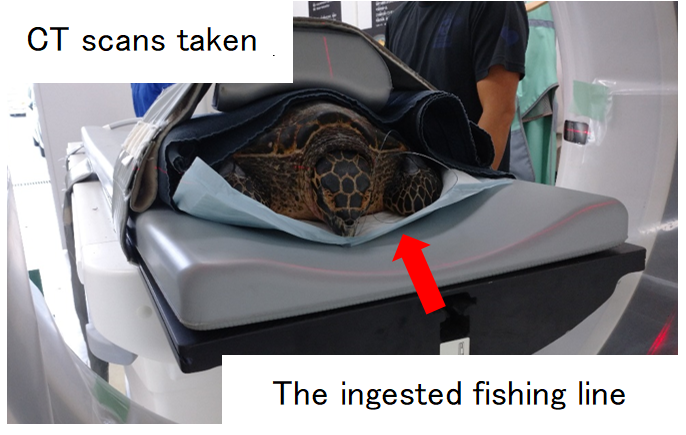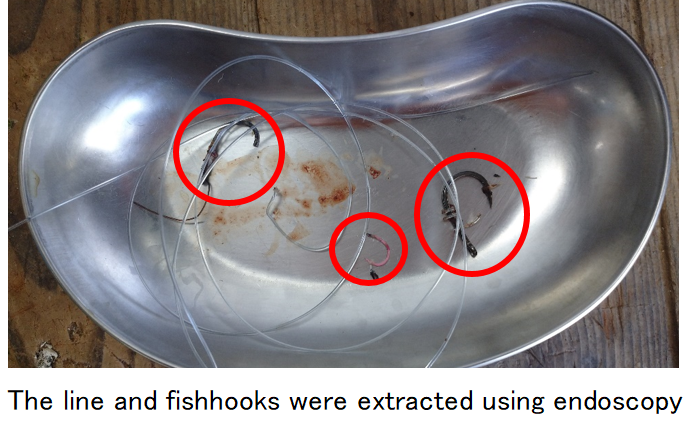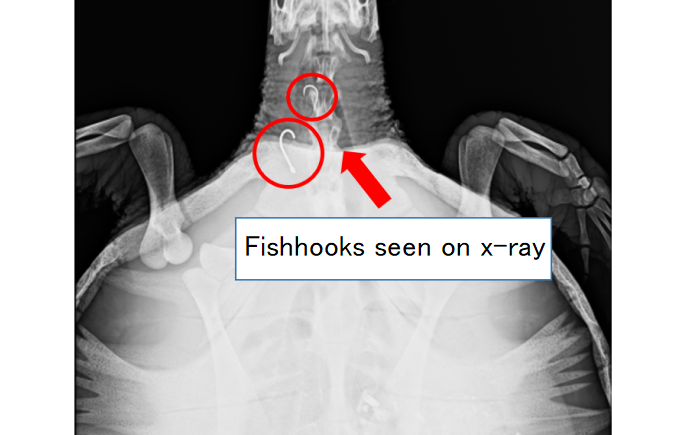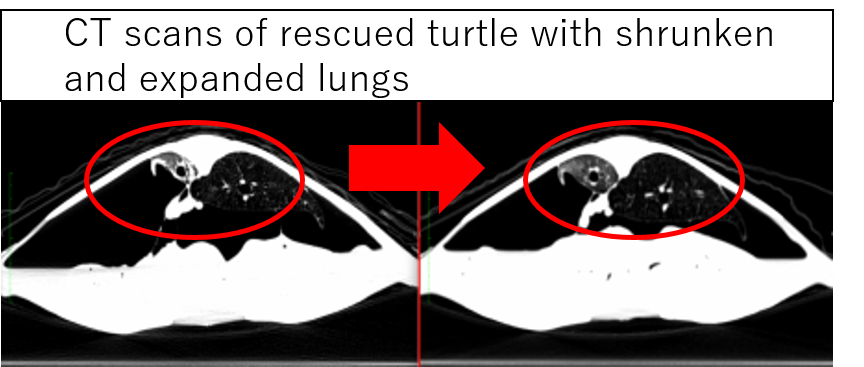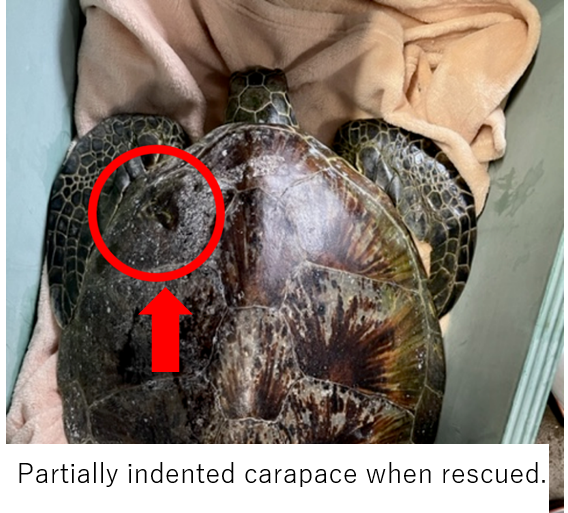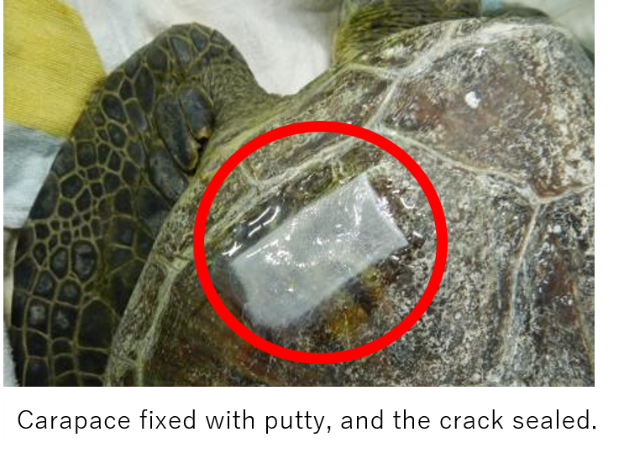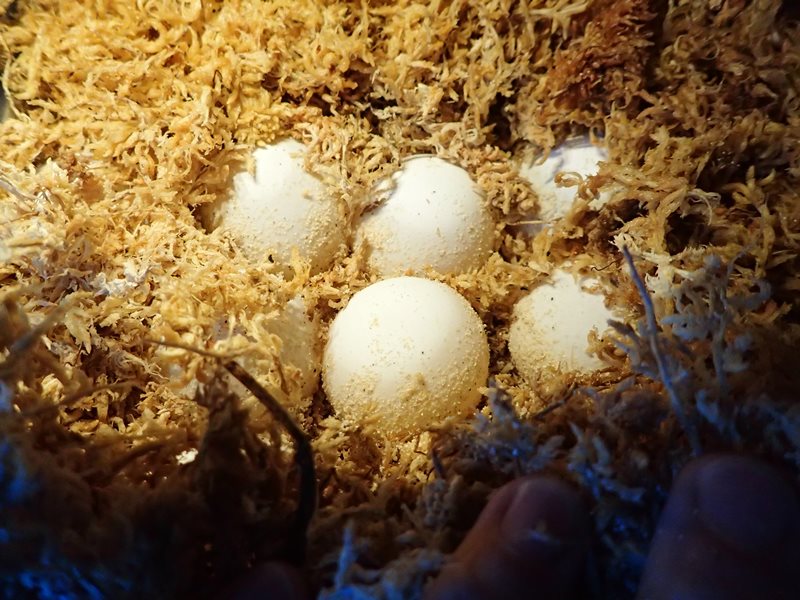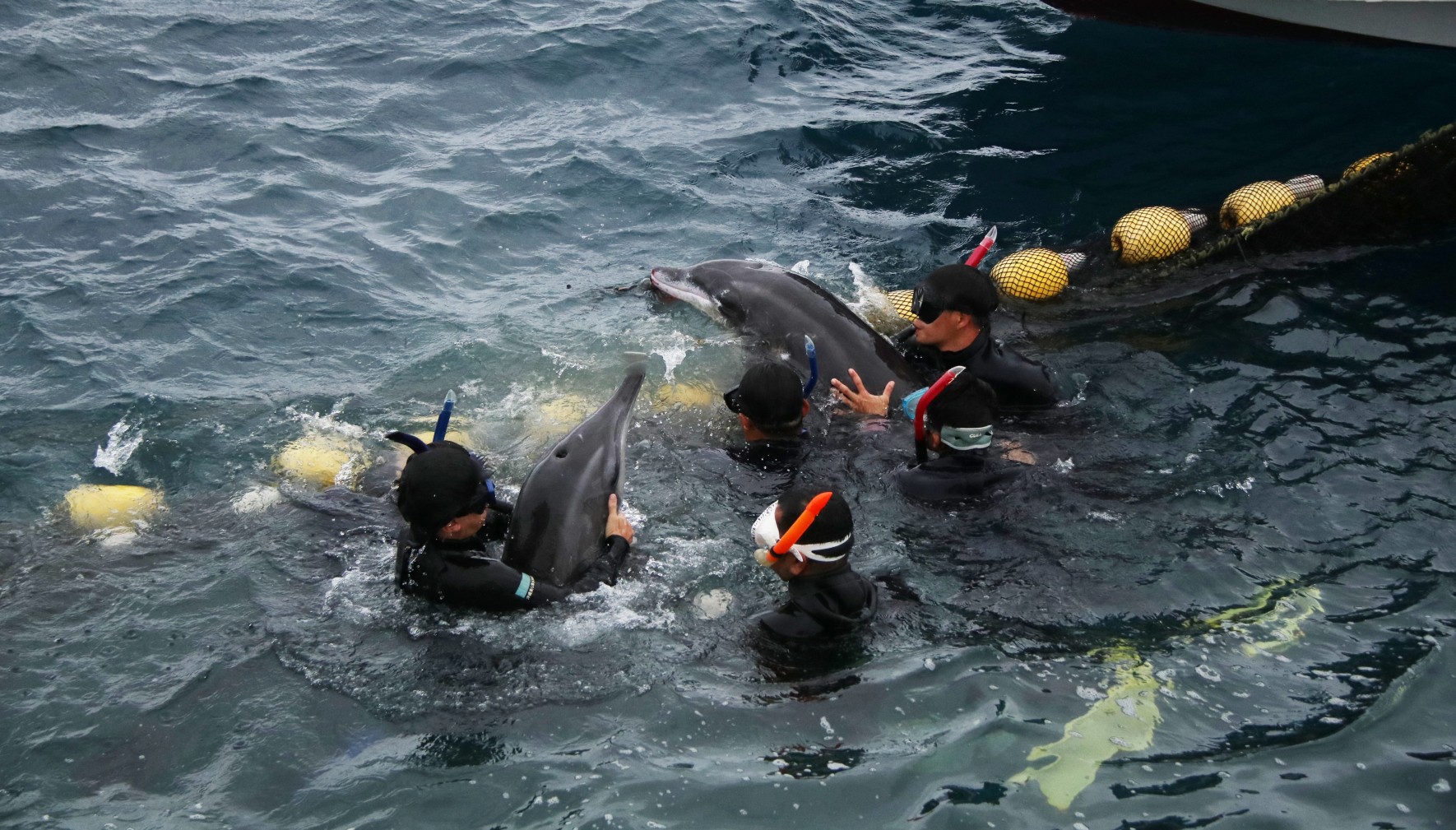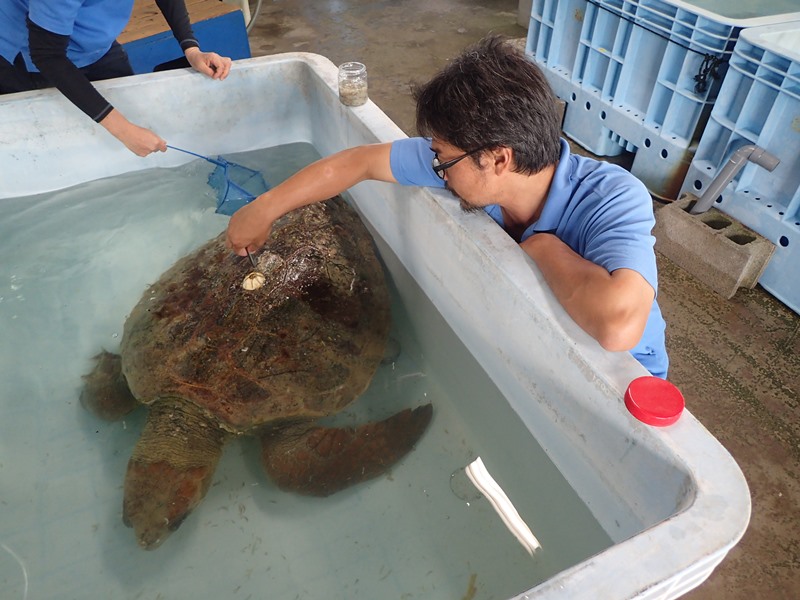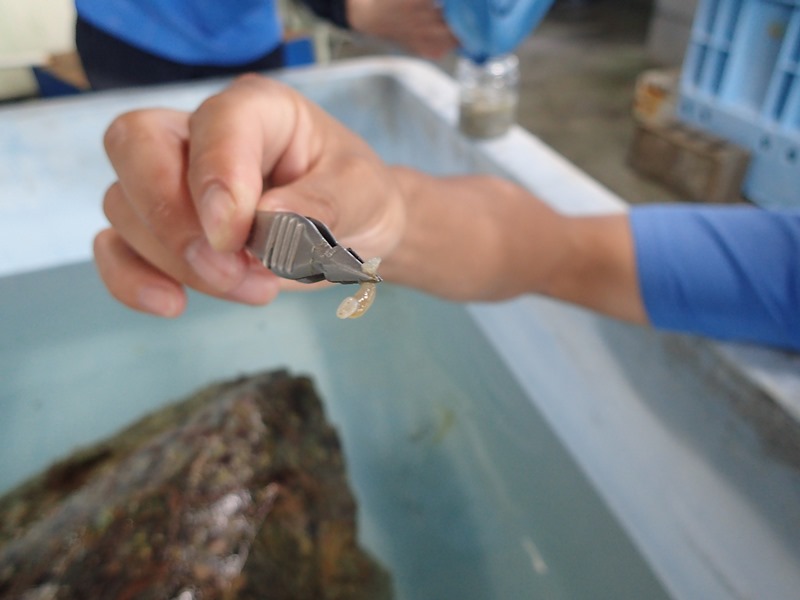Protecting Rare Species
At Okinawa Churaumi Aquarium, we sometimes rescue weakened animals, and release them back into the wild. Our goal is the conservation of the natural environment.
The rescue of an olive ridley turtle from a set net, its treatment, and release
- Date of rescue: September 17th, 2023
- Species / Size: Olive ridley turtle (Carapace 62 cm)
Events leading to its rescue
The turtle was tangled in a set net. It was rescued, brought to the aquarium, and its lungs were checked for injuries.
Its condition after treatment.
A CT scan and an ultrasound showed fluid buildup in the body cavity. The left and right lungs also appeared to be different in size. This caused the turtle to float while swimming. The day after it was rescued, the turtle started to feed well, so it was kept under observation. After two weeks, CT scans showed the size of its lungs appeared to be even. On November 9th, 2023, after confirming its health and swimming ability were normal, it was released from a beach in Ocean Expo Park.

CT scans (Image from October 7th, 2023)
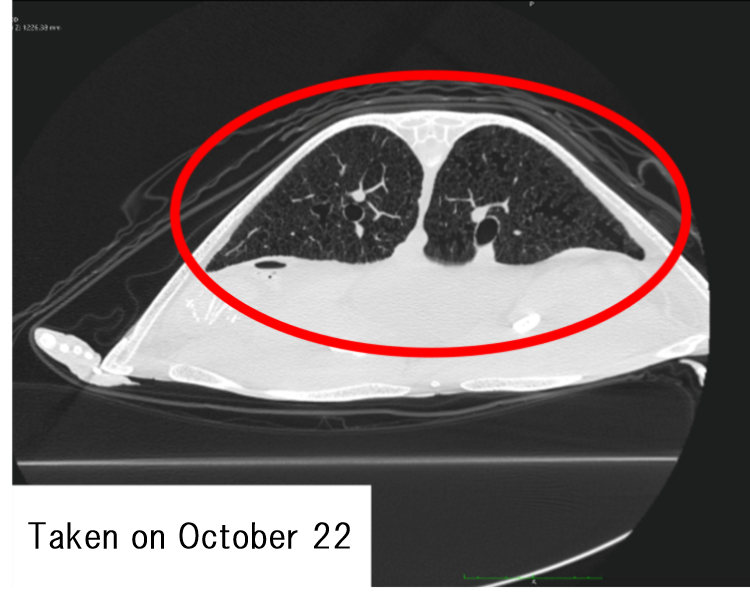
Image from October 22nd, 2023
The injured lungs had recovered.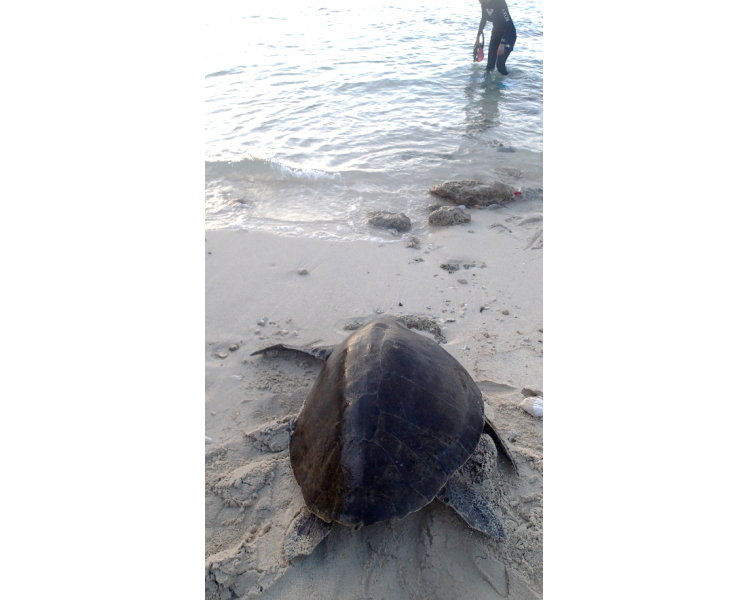
Turtle release
A hawksbill turtle that was rescued at a beach in Onna Village, Okinawa Prefecture, was treated and released.
- Date of admittance: November 24th, 2023
- Location of discovery: Malibu Beach in Onna Village, Okinawa Prefecture
- Species and size: Hawksbill turtle Carapace Length 5 cm
Events leading to its rescue
The turtle was found on a weekend, beached on the shore. Our staff retrieved the turtle, and brought it to the aquarium.
Its state after being treated.
After its rescue, it was reared in a heated tank, but it still struggled to dive.
A blood test showed elevated uric acid levels. This indicated possible kidney dysfunction, so our staff provided the turtle with treatment.
The turtle started to feed, and slowly was able to dive again. On September 19th, 2024, a blood test showed the levels of uric acid had lowered, and the treatment ended. Although its health had recovered, its release was postponed until the following year due to the cold sea temperature. On May 25, 2025, when sea temperatures had risen, the hawksbill turtle was released on the sandy beach of Ocean Expo Park.
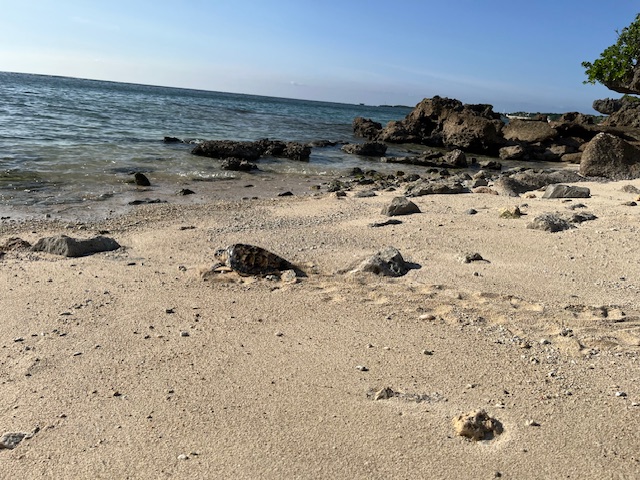
Scene during release
Rescue and release of a weakened green sea turtle found in Nanjo City, Okinawa
- Date found :February 18th, 2023
- Location found:Chinen Misaki Park, Nanjo City, Okinawa
- Species / Size: Green sea turtle / Carapace length 38 cm
Timeline until protection
When found stranded on a beach, half of its body was floating, and its neck was bent. As it was unable to swim properly it was taken into emergency protection by the Okinawa Churaumi Aquarium.
Condition after treatment
The day after it was rescued, the turtle was given a transfusion. A CT scan showed that its right lung had shrunk (atrophied), and this probably caused the weak swimming, and stranding. By adjusting the water level in its tank, it started to feed on its own and its health improved.
On October 15th, 2023, after confirmation of the green sea turtle’s complete recovery of both swimming ability and health, it was released back on to a beach within Ocean Expo Park.
The rescue and release of a hawksbill turtle that had swallowed several fishhooks and was found at Motobu Town, Okinawa Prefecture
- Date found: July 6th, 2023
- Location found:Motobu Town,Okinawa Prefecture
- Species / Size: Length of carapace 49 cm
Sequence of events leading up to rescue
The hawksbill turtle had swallowed several fishhooks. It was brought by our staff to the aquarium.
Condition after treatment
CT scans showed three fishhooks lodged in its esophagus. X-ray scans and endoscopy were used to determine the positions of the fishhooks and lines, then they were extracted. A week after the operation, the turtle had recovered enough to start eating again.
On August 11th 2023, after confirming no issues with its health or swimming ability, the hawksbill turtle was released at a beach within Ocean Expo Park.
Rescue and release of a weakened green sea turtle found on Sesoko Island, Motobu, Okinawa
- Date found :May 20th , 2023
- Location found:Anchi Beach ,Sesoko Island, Okinawa Prefecture
- Species / Size: Green sea turtle / Carapace length 43 cm
Timeline until protection
It was found stranded on a sandy beach. As it floated but couldn’t dive, it was rescued by the aquarium.
Condition after treatment
Results from CT scans showed that its left lung had shrunk, and gas had accumulated in its body cavity. This was causing it to swim poorly and to float. Parasites were also found in its stool. Based on the diagnosis of a veterinarian surgeon, anthelmintics were given and a needle was used to relieve the gas. This resulted in a gradual improvement in its swimming ability.
Around 20 days after its rescue, it had recovered to where it was fully able to feed and reach to the bottom of the pool.
On September 10th, 2023, after confirmation of the green sea turtle’s complete recovery of both swimming ability and health condition, it was released back on to a beach within Ocean Expo Park.
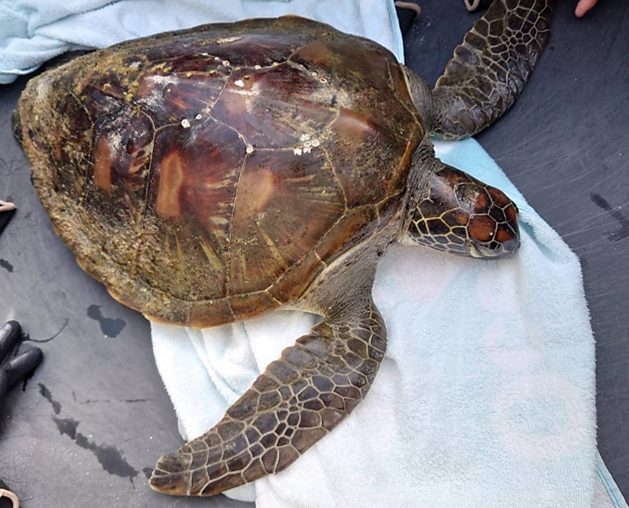
Condition when rescued

Scene during release
Rescue and release of a weakened green sea turtle found in Nanjo City, Okinawa
- Date found:January 23rd ,2023
- Location found:Mibaru Beach, Nanjo City, Okinawa
- Species/ Size : Green sea turtle / Carapace length 47 cm
Timeline until protection
The turtle was found stranded on a sandy beach. Part of its carapace was indented, and as it was having difficulty swimming, it was rescued by the aquarium.
Condition after treatment
The results from CT scans showed that gas was leaking from its shrunken lungs, and the gas had accumulated in its body cavity. The turtle’s carapace had been cracked and indented, and this impact may have caused the damage to its lungs. These injuries would then have resulted in difficulties swimming and it becoming stranded. Based on the diagnosis of a veterinarian surgeon, to prevent further damage to the carapace crack, we fixed it with putty. A needle was used to relieve the accumulated gas. With time, the crack in the carapace sealed and its lungs recovered. Over the course of 20 days from the rescue, the turtle’s swimming ability gradually improved until it was able to feed normally and swim to the bottom of the pool.
On August 11th, 2023, after confirmation of the green sea turtle’s complete recovery of both swimming ability and health, it was released back on to a beach within Ocean Expo Park.
A weakened hawksbill turtle was rescued and released in a fishing port in Onna Village, Okinawa Prefecture
- Date found : October 11th, 2022
- Fishing port in Onna Village, Okinawa Prefecture
- Species and size : Hawksbill turtle and straight carapace length 29cm
Sequence of events until rescue
The turtle was found stranded on a slope at the fishing port, so it was rescued by the aquarium.
Treatment and results
A CT scan showed foreign substances in its intestine.
After giving the turtle an intravenous drip containing vitamin C and other medicines, the sea turtle excreted vinyl along with hard stools.
On May 9th, 2023, the sea turtle had fully recovered and was released at the beach in Ocean Expo Park.
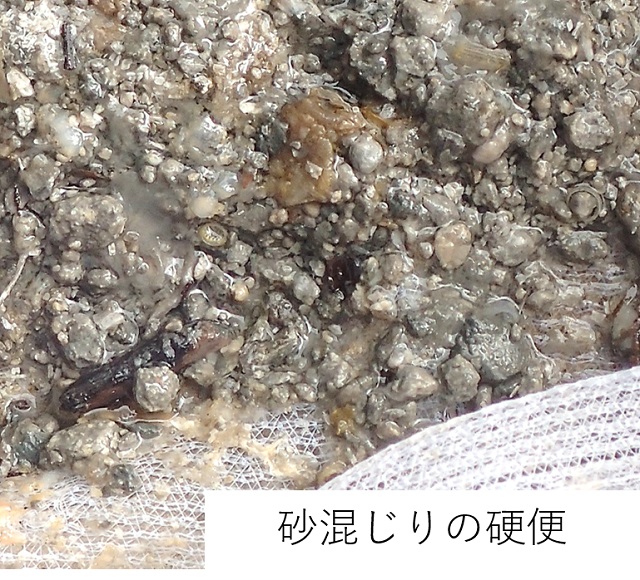
Sand mixed in hard stool

Eating before its release.
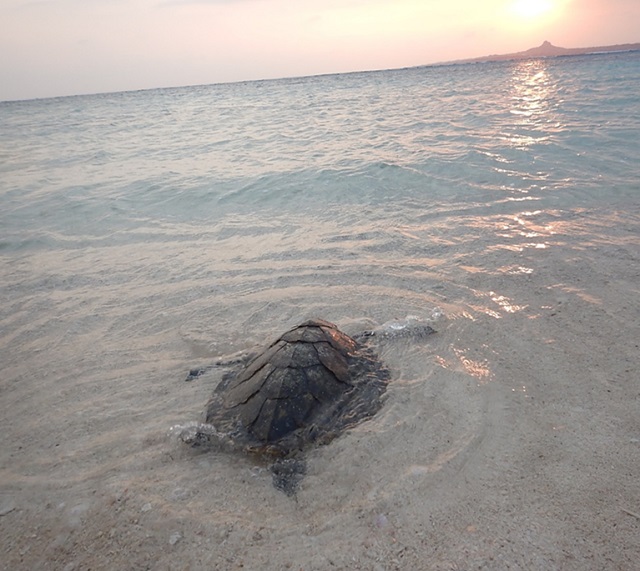
Turtle release
A weakened hawksbill turtle was rescued and released in Ada, Kunigami Village, Okinawa Prefecture
- Date found May 7th, 2022
- Location found : Fishing port of Ada, Kunigami Village, Okinawa Prefecture
- Species and size : Hawksbill turtles and straight carapace length 34cm
Sequence of events until rescue
The turtle was found with its left-side floating unnaturally. It was having difficulty swimming and diving, so it was rescued by the aquarium.
Treatment and results
CT scans and blood tests showed there was gas in the turtle’s abdominal cavity, and its right lung was being compressed and damaged (pneumothorax). An infection could have caused the injury, so antibiotics were given, and the gas was released from its body using a needle. The turtle slowly recovered, and started to swim and dive. One month after its rescue, it recovered to the point it was able to swim to the bottom and feed.
On May 2nd, 2023, after confirming the sea turtle’s health and swimming ability, it was released at the beach in Ocean Expo Park.
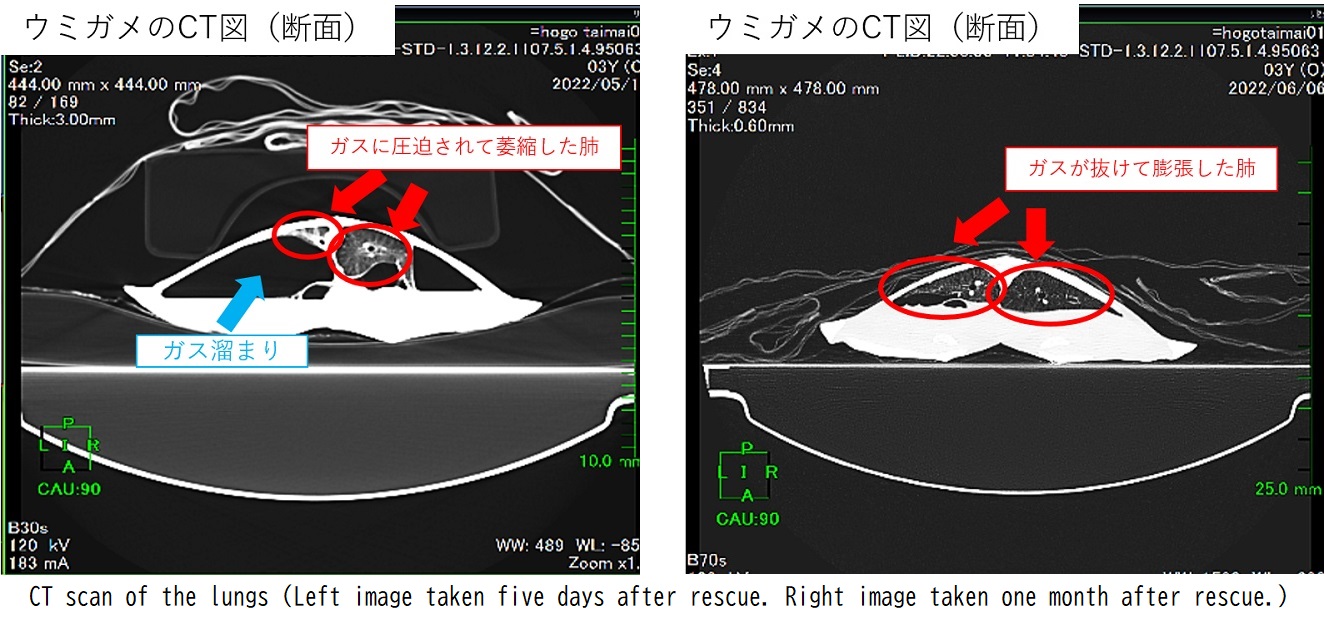
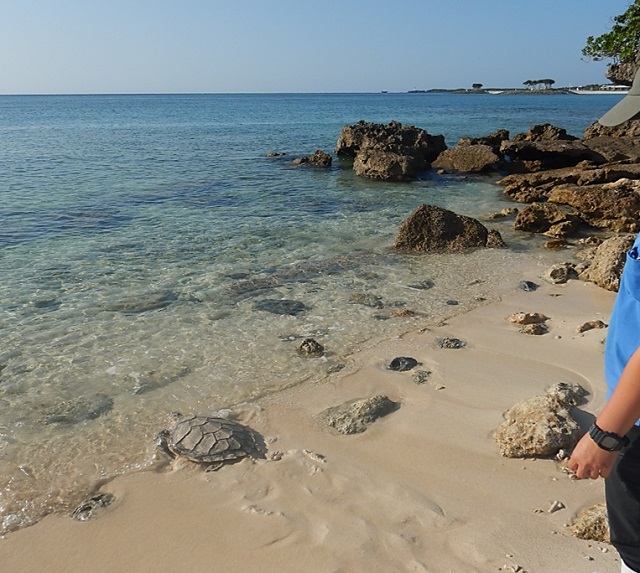
Turtle release
Rescuing a false killer whale that strayed into the fishing port.
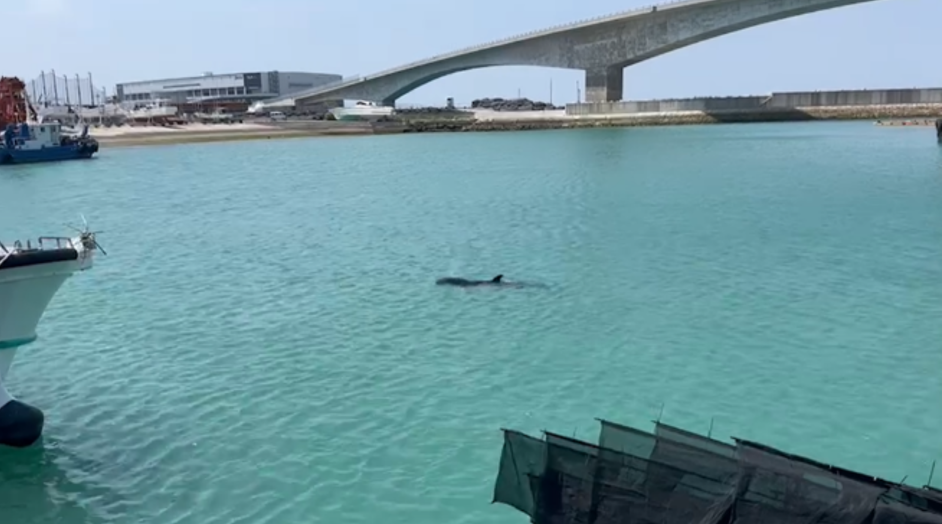
False killer whale in the port
- Date Found:April 23th, 2023
- Location of discovery:Fishing port in Okinawa Prefecture
- Species:One individual
Sequence of events until release
Around noon on April 23rd 2023, we received a call that a young false killer whale had strayed into the fishing port in Urasoe City, Okinawa, and was having difficulty finding its way out.When the Churaumi Aquarium staff checked, they saw that the pup was swimming well. We determined it might yet make its own way out, so decided to continue to observe the false killer whale without disturbing it.
By the morning of April 25th the false killer whale pup was still within the fishing port and could weaken due to the limited fish.
We worked together with the local fisherman and their boats to help guide the false killer whale out of the fishing port. At 8:30am we began to guide out the false killer whale, and three hours later it left the fishing port. To make sure the false killer whale did not return, we led it 2.5 kilometers away from the fishing port, and watched it swim out to the open sea.
Okinawa Churaumi Aquarium will continue to protect wild cetaceans using the knowledge acquired through rearing.
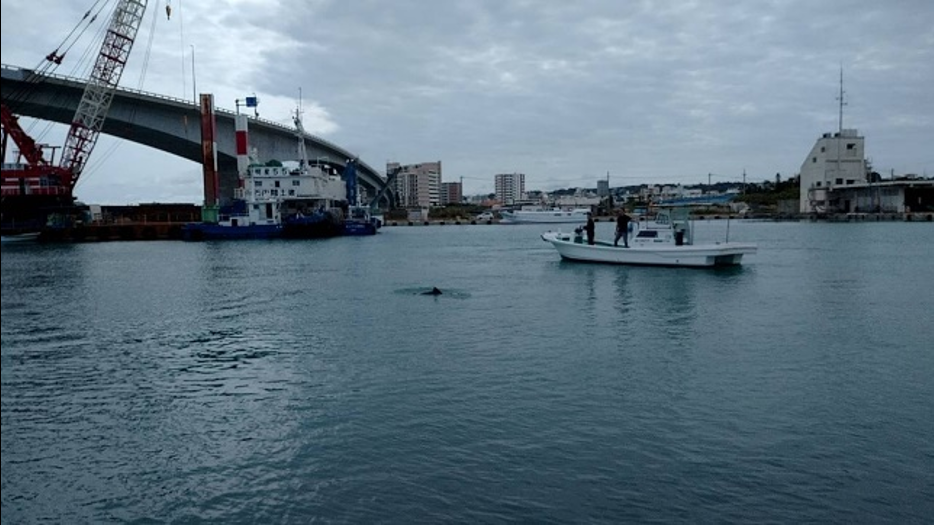
Leading it out of the port
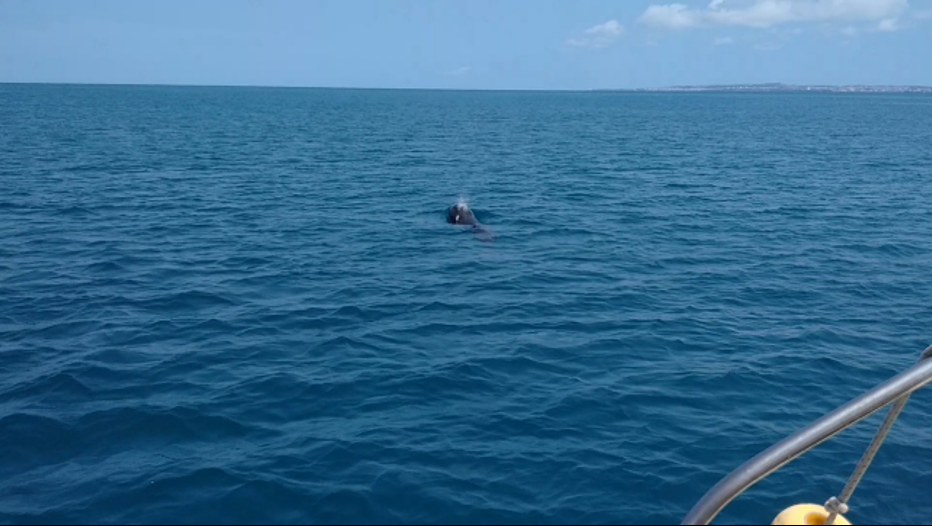
False killer whale swimming out to sea
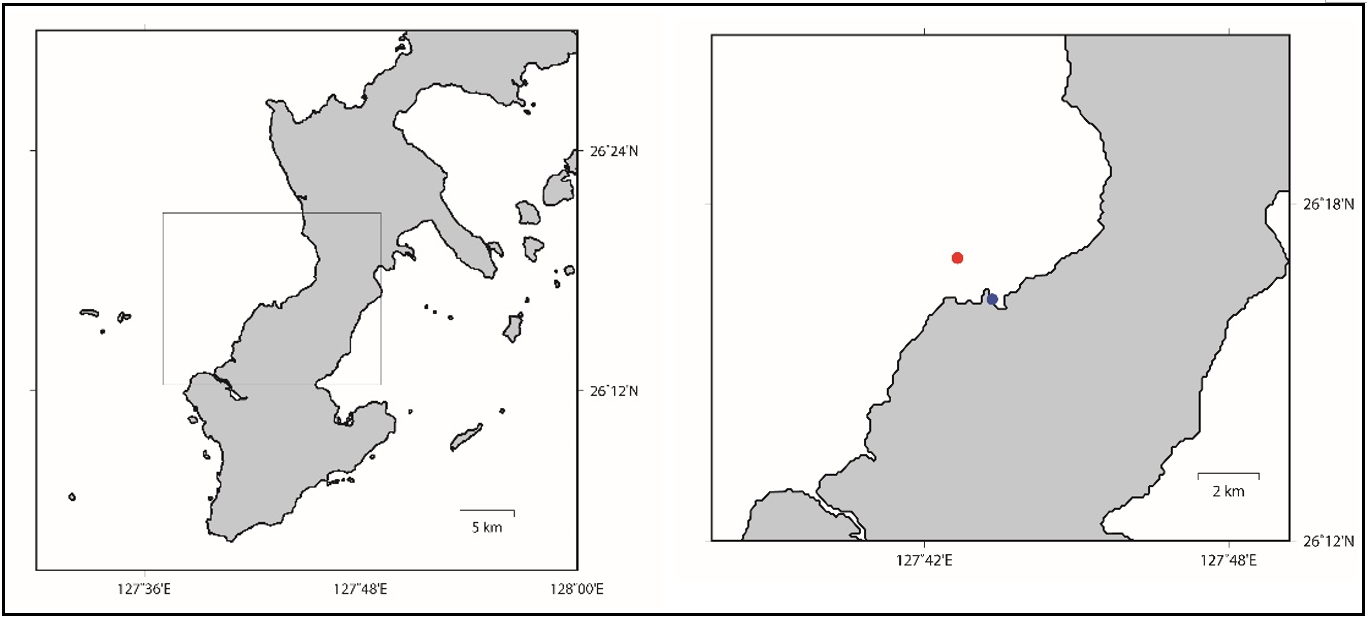
(Red pin) location of release.
(Blue pin)location of discovery.
Protection of Green turtle eggs
- Date Found:February 4th, 2022
- Location of discovery:Beach in Motobu Town, Okinawa Prefecture
- Species:119 Green turtle eggs
Timeline until protection
On February 4th 2022, a Green turtle laid her eggs on the beach near the Ocean Expo Park. In Okinawa Prefecture, Green turtles usually lay eggs from June to August. In February, when night temperatures are often below 15 ℃, embryos in the eggs would not normally survive. To save the turtles, the clutch of Green turtle eggs were taken back to the aquarium and placed in incubators.
On April 3rd 2022, the eggs began to hatch and 20 baby turtles hatched. Usually we try to release hatchlings into the ocean right away, but in April the water temperature is 21.5 ℃, which is too cold for the hatchlings. For this reason, these baby sea turtles will be released this summer when the majority of Green turtle hatchlings are released to the ocean.
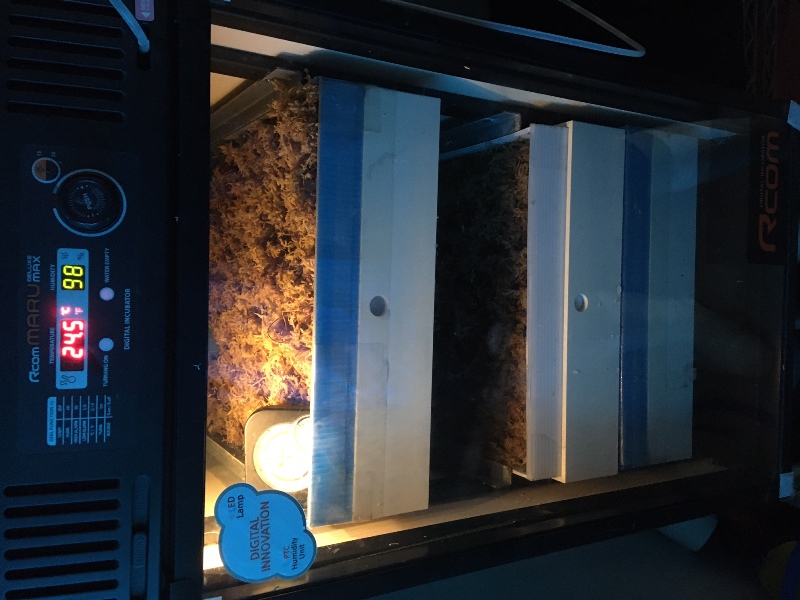
Incubator used to house the eggs
Eggs inside the incubator
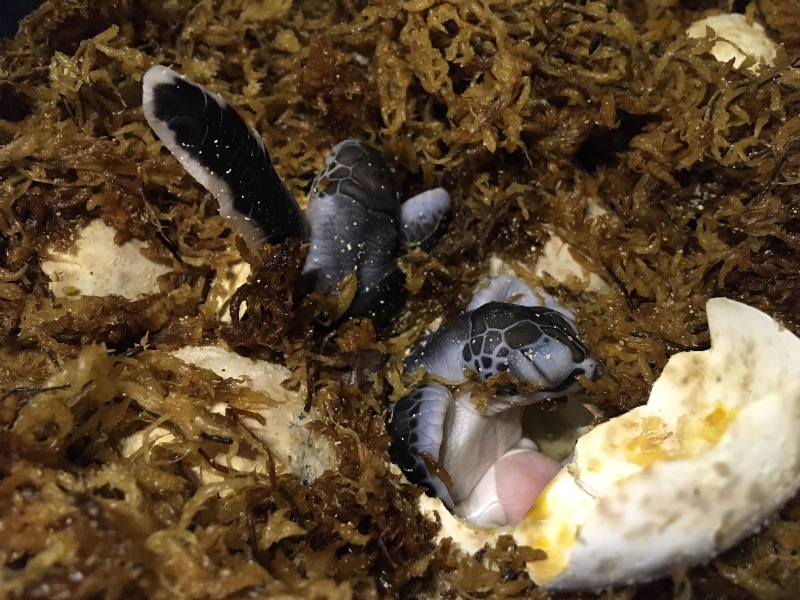
Hatchlings
The release of a green turtle rescued off of Aka Island.
- Date Found:November 6th,2021
- Location of discovery:Aka Island Zamami Town, Okinawa Prefecture
- Species:green turtle
Timeline until protection
On November 6th, 2021, a green turtle was found by people from a local diving shop on the ocean surface offshore of Aka Island, Zamami Village. It was rescued by being lifted into the dive boat, and then loaded on to a ferry and taken to a Naha City port.
After treatment
The rescued individual was a female with a carapace length of 94 cm, and it weighed 115 kg. Since its rescue, its neck remained slanted, and it floated at an angle.
A CT scan showed the left and right lung were inflated at different amounts, and there was gas in the digestive tract. These factors caused it to float on the surface at an angle.
Our staff provided medical treatment and a controlled diet to quicken the excretion of the accumulated gas, and the water level in the tank was changed to correct it floating at an angle.By August 2022, the treatment allowed the green turtle to swim underwater stably. After further rehabilitation using the deep dolphin pool, it was released back into the ocean offshore of Ocean Expo Park on November 8th, 2022.
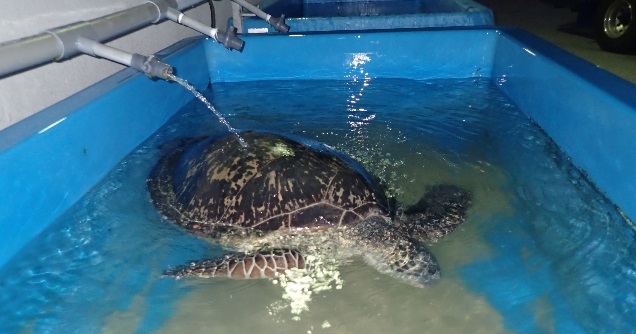
Condition when rescued

CT scans
(Left image is when it was rescued one month ago.
Right image is the day before its release)
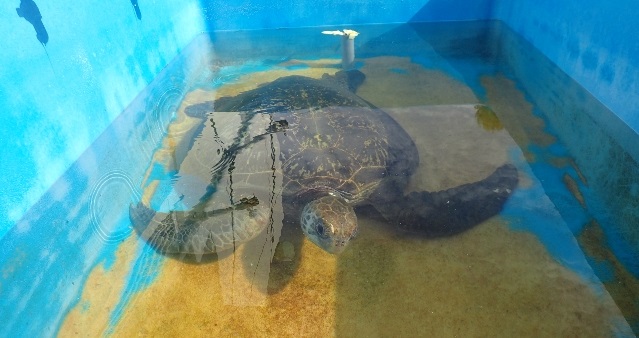
Just before it was released in the ocean
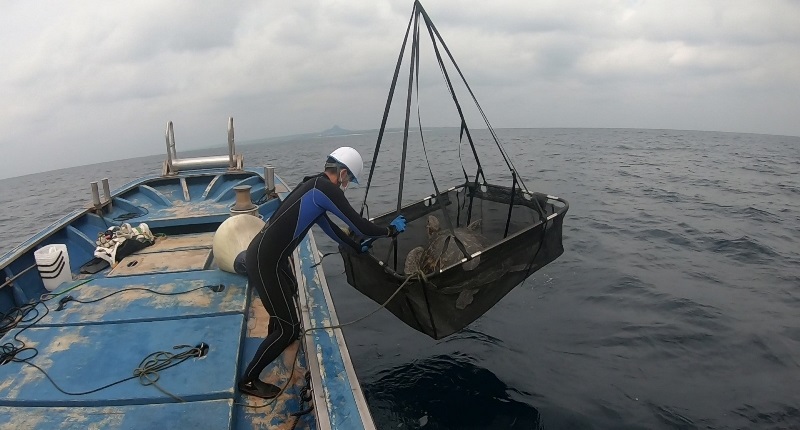
The release taking place at sea
A green sea turtle found on a beach in Chatan Town, Okinawa Prefecture
- Date of discovery November 11th, 2021
- Place of discovery: Chatan Town beach, Okinawa Prefecture
- Species and size: Green sea turtle (juvenile) Carapace length 6.5 cm
Before rescue
It was found weak and stranded on the beach
After treatment
After the sea turtle was rescued by the aquarium, we performed CT scans and gave intravenous saline to help it recover. We treated and disinfected its injured rear flipper, but sadly the turtle died the next day.
An autopsy revealed a large amount of pumice rock and plastic waste in its stomach. We do not know for sure if the pumice was the direct cause of death. However, the intestines of a juvenile sea turtle are narrow, and the pumice may have become an intestinal obstruction.
If pumice rocks continue to be present on the water surface, it is possible that other juvenile sea turtles may accidentally eat them. The aquarium will continue to protect and assist sea turtles that need rescue and medical assistance when they are affected by marine debris or pumice rocks.
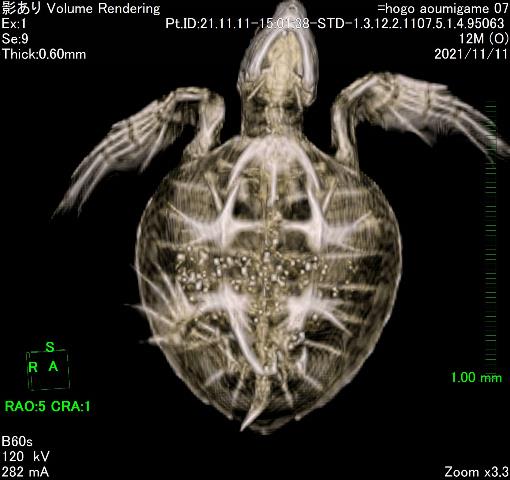
CT scan images

Pumice rocks and debris from its intestine
Sea turtle eggs are laid on sandy beaches, and the turtles hatch around 2 months later. Hatchlings emerge from the sand, rush to the water, then swim out to sea for a day. Once safely offshore, it is thought the hatchlings stop swimming, and float in the water.
The deceased sea turtle may have got caught in an ocean current, then accidentally ingested plastic waste and pumice.
We have rescued and released turtles at beaches in Nago City, Okinawa Prefecture.
- Date of discovery July 7th, 2020
- Place of discovery: Nago City beach, Okinawa Prefecture
- Species and size: Green sea turtle Carapace length 44.4cm weight 6.9kg
Before rescue
It was found weak and stranded on the beach
Progress after diagnoses
Its left front flipper had been injured, but the wound had healed. The results from a CT scan and blood tests showed a large volume of gas in its body. This would have reduced its ability to swim, and led to the stranding.
When rescued, the trapped gas still caused the turtle to float, and limited its ability to swim. The following day, it recovered its appetite, and began to feed. As the gas was excreted, its ability to swim also recovered.
On June 18th, 2021, the sea turtle was swimming normally, so it was released at a beach within Ocean Expo Park.

Condition when rescued

The gas in its body caused the rear of the turtle to float
Loggerhead sea turtle’s eggs were relocated to a beach in Motobu Town, Okinawa Prefecture.
- Date of discovery May 16th, 2021
- Place of discovery: Sandy beach within Motobu Town, Okinawa Prefecture
- Species and number of eggs : Loggerhead sea turtle’s eggs (140 eggs)
Before rescue
A sea turtle nest, that had probably been laid the previous night, was found on a sandy beach near Ocean Expo Park. There were plans for a water pipe construction on that beach the following autumn. Although construction would not occur during nesting and hatching season, there were concerns the nest could be affected during preliminary surveys. Therefore, with the assistance of the local sea turtle rescue team, the eggs were moved to a different location.
The location of the turtle nest was deduced by following the tracks of the turtles. After extracting the eggs from the nest, the eggs were relocated to a different area of the same beach that would not be affected by construction. We dug a similar hole to the original nest, and placed the eggs in there. The hatchlings are expected to emerge in July or August.
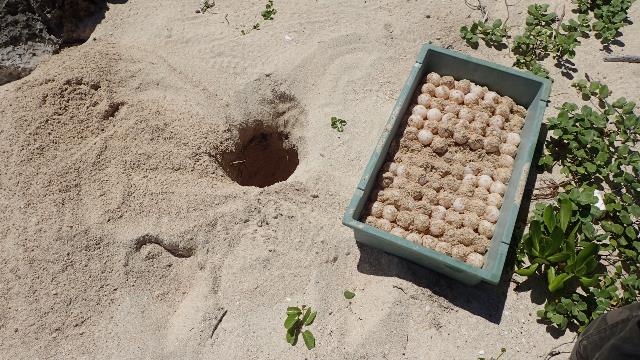
The nest and the removed eggs.
Loggerhead sea turtles were rescued and released in Itoman City, Okinawa Prefecture
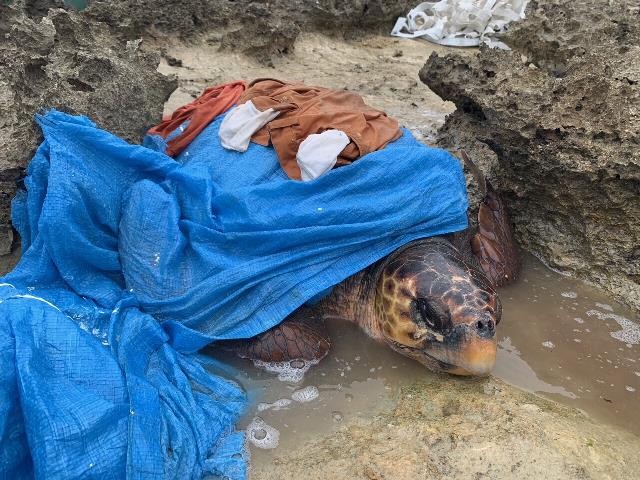
Condition when rescued
- Date of discovery May 5th, 2021
- Place of discovery: Kyan, Itoman City, Okinawa Prefecture
- Species and size: Loggerhead sea turtle Carapace length 89.0cm weight 106kg
Before rescue
After laying her eggs, the turtle became stuck on the reef and could not move
After treatment
After receiving the turtle, we conducted blood tests, and bathed the turtle to remove all the parasites. The underside of its carapace (shell) had scratches from crawling over the rocky reef at low tide, but the blood tests showed no problems. The ultrasound showed that eggs were forming in the turtle, so it was determined it should be released back into the wild quickly. On May 14th, a week after the rescue, and after all blood tests and health checks were completed, the sea turtle was released back onto the beach near where it was found.

Ultrasound imaging
Release of rough-toothed dolphins that had become trapped in a fixed net
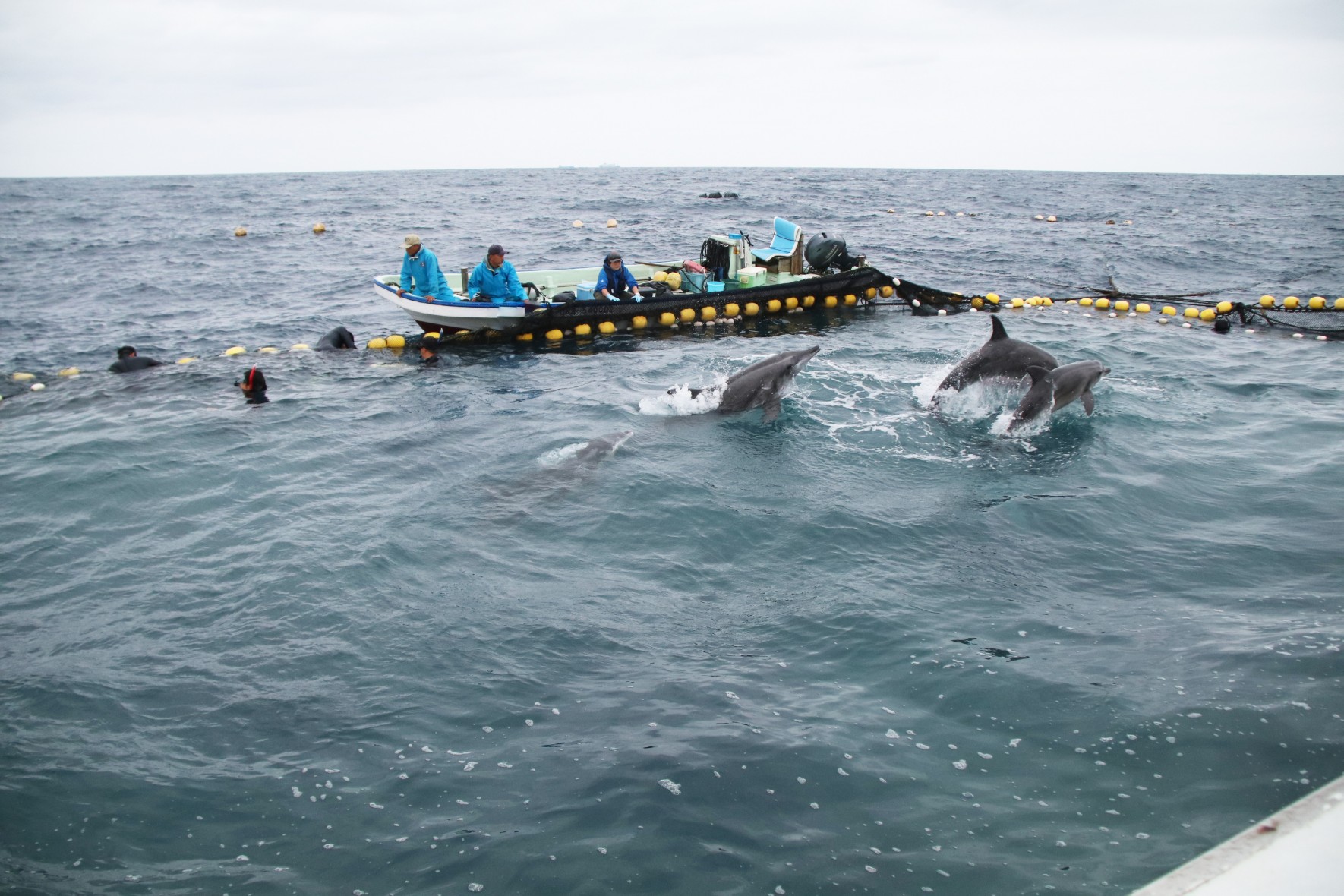
Rough-toothed dolphins in the net
- Date of discovery March 4th, 2021
- Species: eight rough-toothed dolphins
Before release
Early morning on March 4th, 2021, eight rough-toothed dolphins had become accidentally caught in a fixed net. Working with the fisherman, our staff helped to keep the dolphins from drowning and guided them out from the net. All the dolphins were safely released.
Guiding the dolphins out from the net
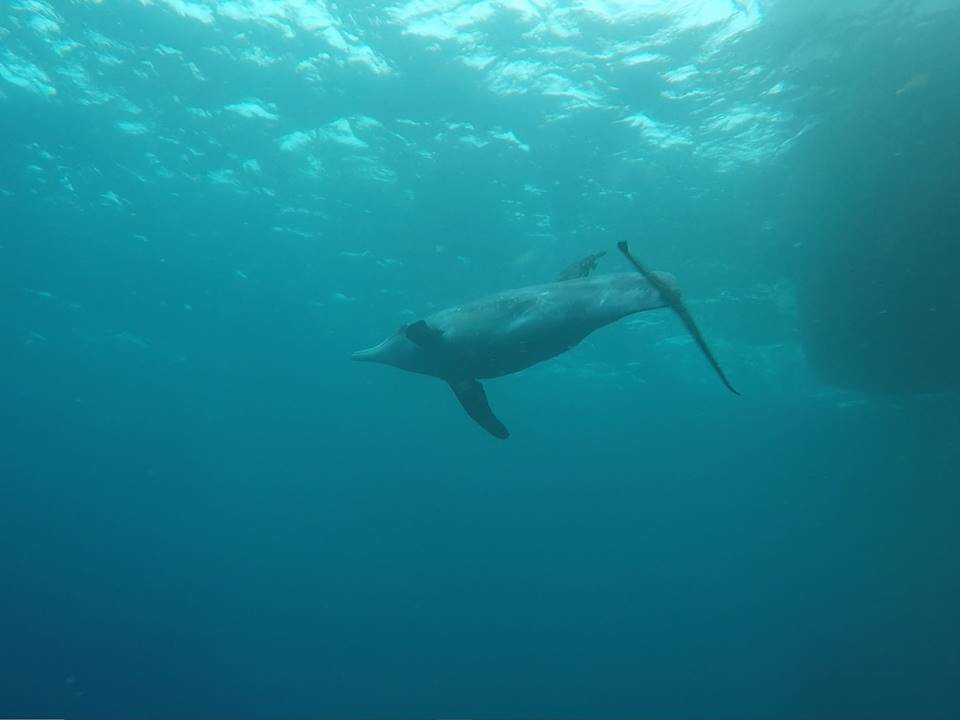
The dolphins swimming away from the net
Progress after their release
Before the release of the dolphins, we tagged the dorsal fin of one dolphin with a satellite-linked transmitter. We were able to track its movements as it swam in the local area, until the tag dropped off several days later.
*The tagging with the satellite-linked transmitter was done under the supervision of a veterinarian and with permission from Okinawa Prefecture.
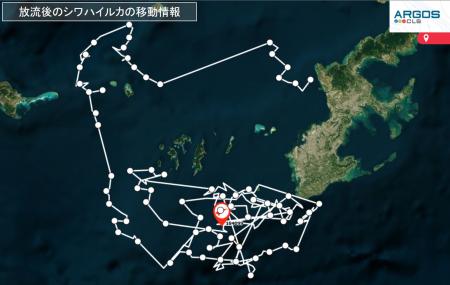
Rescue and release of a weakened green sea turtle from a beach in Itoman City, Okinawa Prefecture

Condition when rescued
- Date of discovery January 30th, 2020
- Place of discovery: A beach in Itoman City, Okinawa Prefectur
- Species and size: Green sea turtle Carapace length 36.4cm weight 4.7kg
Before rescue
It was found weak and stranded on the beach
Diagnosis and treatment
Blood tests and a CT scan showed gas trapped in its digestive tract. We believe the sea turtle was stranded on the beach because of difficulties swimming. Its feces contained parasite eggs, and the turtle may have had a bacterial infection. The sea turtle was treated with a vitamin intravenous drip, and given antiparasitic drugs and antibiotics.
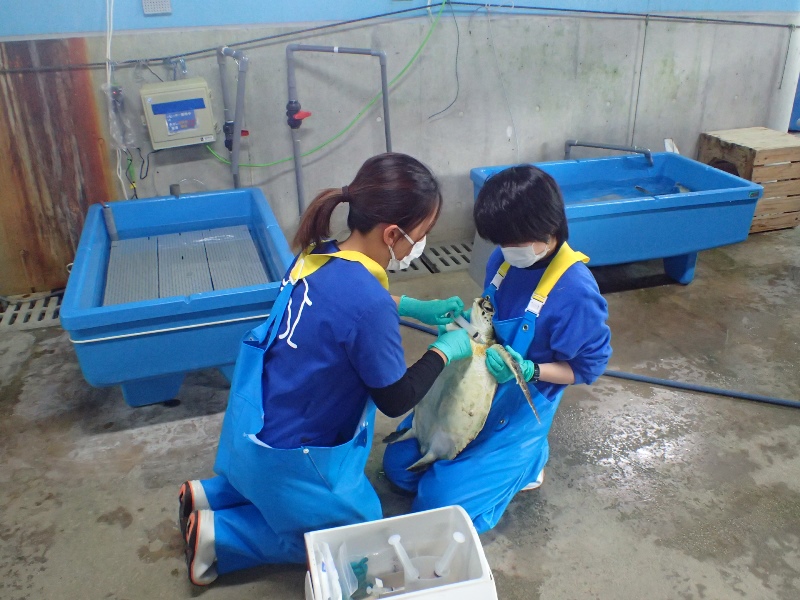
Treatment
After treatment
Several days after starting treatment, the turtle recovered and began feeding. The blood levels, and trapped gas within the digestive tract also improved. Four and a half months later, on June 18th, 2021, it was released at a beach within Ocean Expo Park.
Rescue and release of a loggerhead sea turtle from Arume, Higashi Village, Okinawa Prefecture
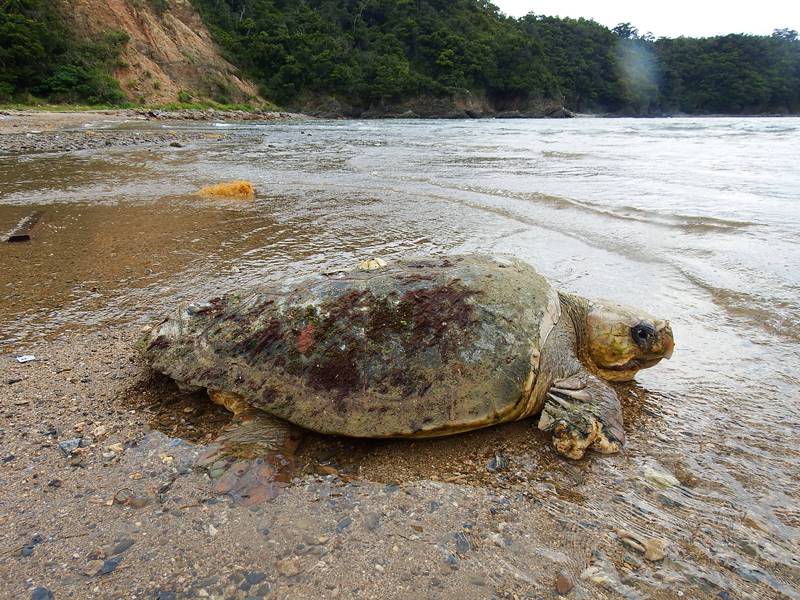
Condition when rescued
- Date of discovery May 3rd, 2017
- Place of discovery: Arume Coast, Higashi Village, Okinawa Prefecture
- Species and size: Loggerhead sea turtle Carapace length 80.0cm weight 67.0kg
Before rescue
The locals assisted in its rescue from the beach
Diagnosis and treatment
Its right front flipper and left rear flipper looked to have been bitten by another animal. The surface of the turtle’s body was infested with Ozobranchus branchiatus (a blood-sucking leech). The blood test revealed severe dehydration and possible anemia. The turtle was bathed to remove the parasites and intravenous liquids were administered every day to help it recover from dehydration.
Removal of parasites
Ozobranchus branchiatus (parasitic leech)
After treatment
Six days after treatment began, the sea turtle had recovered enough to feed. With the parasites removed, its blood levels improved. On June 11th, 2020 the sea turtle was released at a beach in Ocean Expo Park.

